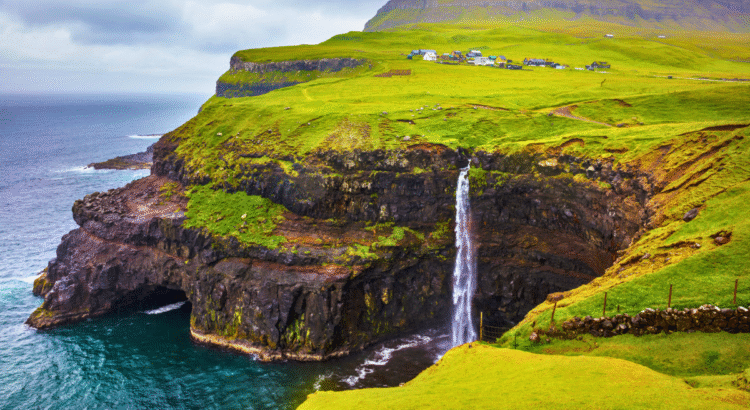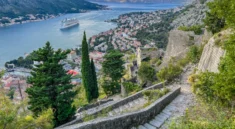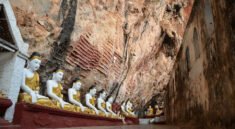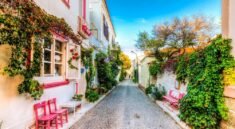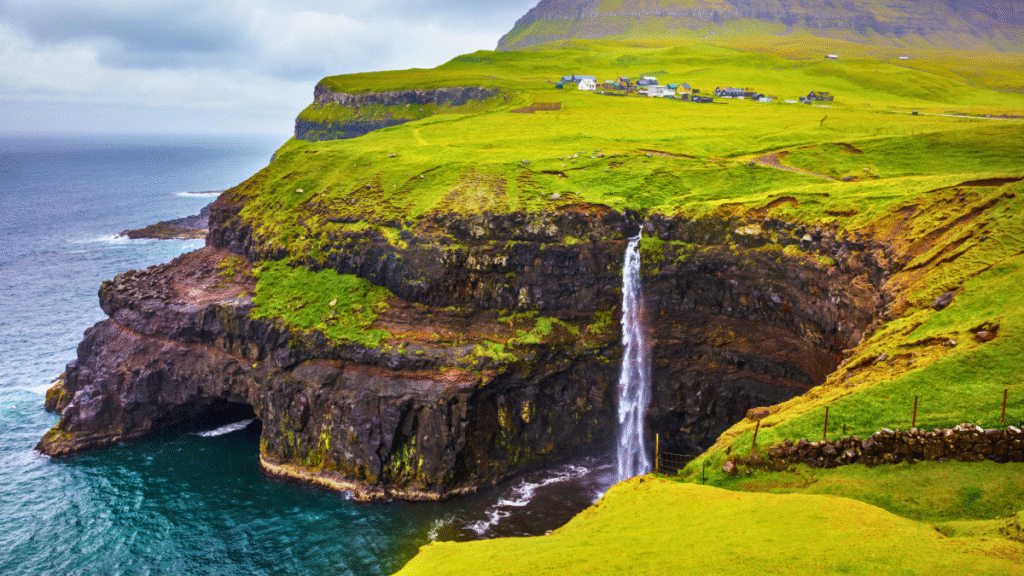
Tucked away in the North Atlantic Ocean, between Norway and Iceland, lies a land so remote, so unspoiled, that it feels almost mythical. The Faroe Islands, an archipelago of 18 volcanic islands, rise like green dragons from the sea. Rugged cliffs plunge straight into wild waters, turf-roofed cottages dot the hills, and flocks of sheep roam freely—often blocking the narrow roads. With a population smaller than a midsize town and more sheep than people, the Faroes are not just a destination—they are a soul-resetting experience where modern chaos fades into silence and nature takes the lead.
This is not a place of resorts, shopping malls, or high-rise hotels. It’s a place of wind-whipped cliffs, grass-covered mountains, and deep, mythic stillness. It is a place where waterfalls cascade directly into the ocean, where fog weaves between fjords like ancient spirits, and where the measure of time shifts from clocks to tides, wind, and weather.
A World Untouched: The Allure Of Isolation
The Faroe Islands are among the most isolated inhabited places in Europe. With a population of just over 50,000 people spread across 18 islands and countless tiny villages, life here flows at its own deliberate rhythm. There are no long lines, no overbooked hotels, no background noise of tourist crowds. Instead, there is space—space to breathe, to think, and to be.
Here, isolation is not a limitation but a luxury. The lack of distraction brings clarity. The silence isn’t empty—it’s full of meaning. Every gust of wind, every crashing wave, every bleating sheep becomes part of a soundscape that is ancient and grounding.
You’ll quickly notice how your pace slows. Walking becomes meditative. Eating is savored. You begin to tune into the land—its moods, colors, and whispers.
Waterfalls That Drop Into The Sea
Among the Faroe Islands’ most iconic images is the Mulafossur Waterfall in the village of Gásadalur. The sight is otherworldly: a narrow stream flowing from a tranquil highland, cascading off a towering cliff, and plunging directly into the churning Atlantic below. Behind it stands a handful of turf-roofed homes, and beyond, nothing but ocean stretching to infinity.
This view captures the essence of the Faroes—raw, surreal, and cinematic.
But Mulafossur is not alone. The islands are laced with waterfalls, both dramatic and gentle, many unnamed and unexpected. Rain and mist feed these streams constantly, turning every hike into a potential encounter with a hidden cascade. Some are fed by melting snow, others by mountain springs. Some fall in sheets, others trickle like lace.
The constant dance between water and rock gives the landscape a living quality—as if the land itself is breathing.
Sheep: The True Locals Of The Faroes
It’s said that there are twice as many sheep as humans in the Faroes, and once you arrive, it’s hard to disagree. Sheep roam the countryside, nap on roadsides, graze on cliffs, and stare you down with stoic confidence. Their presence is so central that even the name “Faroe” derives from the Old Norse Færeyjar, meaning “Sheep Islands.”
These animals are more than picturesque; they are woven into Faroese culture. Their wool is still used for warm, handmade sweaters. Their meat, especially skerpikjøt (wind-dried lamb), is a national delicacy. They are part of family economies and seasonal traditions.
But they also symbolize something greater: the harmony of life here. Humans don’t dominate the landscape—they share it, respectfully, with nature. There are no fences, no factory farms. Just open hills, cold sea winds, and the quiet companionship of woolly neighbors.
Villages Frozen In Time
The villages of the Faroe Islands feel like postcards from another century. Saksun, with its black wooden church and grass-roofed cottages, sits cradled in a steep-walled valley overlooking a tidal lagoon. During low tide, you can walk along the seabed to a hidden beach where cliffs dwarf you on either side.
In Gjógv, colorful houses line a stream that runs through a natural sea gorge. The village is framed by towering mountains and the roaring Atlantic, yet it exudes quiet peace. Children play outside without fear, locals wave to every visitor, and daily life unfolds with gentle dignity.
Then there’s Tjørnuvík, at the end of a winding road, with black sand beaches and views of the iconic sea stacks Risin and Kellingin—legends turned to stone. Even in the rain and fog, the village’s warmth shines through.
There are no flashy signs or commercial hubs. Just intact traditions, timeless aesthetics, and welcoming hearts.
Nature’s Playground: Hiking And Exploration
The Faroe Islands are a dream for outdoor enthusiasts. Nearly every trail leads to breathtaking views—from high ridgelines where you can see multiple islands at once, to narrow cliff paths where puffins and seabirds wheel overhead.
Popular hikes include:
- Slættaratindur: The tallest mountain in the Faroes. On clear days, the summit provides 360-degree views of the archipelago.
- Trælanípa and Lake Sørvágsvatn: A famous optical illusion where the lake appears to hover above the ocean. A short hike brings you to a stunning clifftop view of the Bøsdalafossur waterfall crashing into the sea.
- Kallur Lighthouse on Kalsoy: A trail leading to a windswept lighthouse perched above vertical cliffs, with views so wild they were featured in a James Bond movie (No Time to Die).
The air is crisp. The silence is profound. And the landscape—painted in green, gray, and silver—is constantly changing with the weather.
The Weather: Ever-Changing And Alive
If there’s one thing you can’t control in the Faroes, it’s the weather. It changes hourly, sometimes by the minute. Sunshine can give way to fog in moments. A still morning can turn into a windstorm by afternoon. But this unpredictability is part of the magic.
You learn to pack layers, carry rain gear, and adapt. You start to watch clouds like a sailor, listening to the wind like an old friend. Weather here isn’t a nuisance—it’s a storyteller, shaping your experience, guiding your footsteps, and revealing the islands’ many moods.
Time Slows Down: Digital Detox And Mindful Living
In the Faroe Islands, time stretches. Without crowds, advertisements, or hectic schedules, you begin to live by the light, not the clock. Mornings are slow, filled with fresh air and hot coffee. Afternoons might involve a quiet walk, a chat with a local, or simply sitting beside a cliff, listening to the sea.
There’s little Wi-Fi in the more remote villages, and mobile signal can be patchy. But that’s a gift, not a drawback. You begin to disconnect—not just from devices, but from the mental noise of modern life.
Books are read. Journals are filled. Thoughts are allowed to deepen. The islands create space not just in geography, but in the soul.
Cultural Identity: A Blend Of Nordic And Fierce Independence
Though part of the Kingdom of Denmark, the Faroe Islands have their own government, language (Føroyskt), and strong cultural identity. The people are resilient, proud, and deeply connected to their land. Traditional music, storytelling, and seasonal festivals continue to thrive.
The Ólavsøka Festival in July celebrates Faroese heritage with rowing races, folk dances, and national dress. The Faroese chain dance—an ancient tradition sung in Old Norse ballads—is still performed, not for tourists, but for memory and meaning.
Despite modern comforts, the Faroes have retained their authenticity. You are not a consumer here—you are a guest in a living culture.
Cuisine From The Land And Sea
Faroe Islands cuisine is honest, elemental, and rooted in survival. With limited farmland and a harsh climate, food has traditionally been preserved through fermentation, drying, and salting.
You’ll find:
- Skerpikjøt: Air-dried lamb, aged in open sheds using wind and time.
- Grindadrap: A controversial traditional practice involving pilot whale meat (not commercialized, and subject to international debate).
- Fresh seafood: Including salmon, mussels, and langoustines caught hours before serving.
New Nordic chefs in places like KOKS—the islands’ Michelin-starred restaurant—have brought global attention to Faroese ingredients. Their philosophy? Let nature lead. Let flavor speak slowly, like the land.
Leaving With More Than Memories
The Faroe Islands don’t offer typical souvenirs. There are few gift shops. Instead, you leave with something intangible: clarity.
Clarity about what matters. Clarity about space, silence, and stillness. About how the world can be lived slowly and beautifully. About how a place without crowds, noise, or luxury can still be one of the most luxurious experiences of your life.
You may arrive as a traveler, but you leave as a witness to a hidden rhythm—one that continues long after your plane departs.

